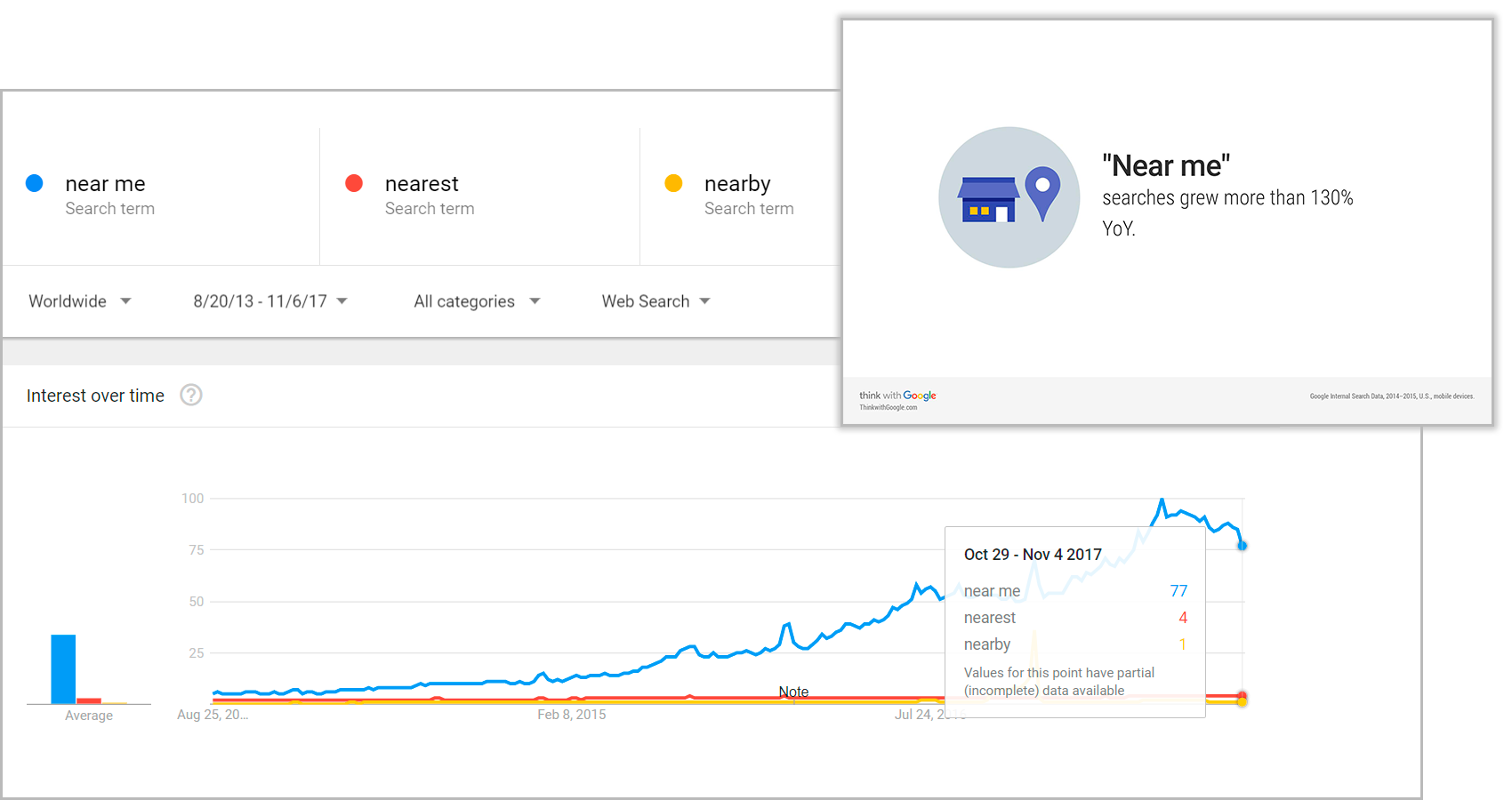The Step-by-Step Guide to Optimizing for Voice Search
13 November 2017 Leave a comment ALL-HANDS SEO
The digital age is moving at the speed of light and voice search is not a cutting-edge technology; things that seemed very sophisticated and innovative suddenly became mainstream. A lot of you probably talked to your digital assistant today to inquire the weather forecast or set the alarm. It’s exciting news for users and IoT fans, but how do we adapt our SEO strategies to fit into the rapidly evolving framework of voice-based search?

In this article we’ll take a quick look into the history of how voice search developed to the point where it is now. We’ll also provide you with few tips on how to adjust your content strategy and ad campaigns with voice search in mind.
The History of Voice Search
Having a variety of sophisticated technologies surrounding us every day, we often take them for granted. Nevertheless, there are fascinating stories of rises and falls behind every one of them, and your charming voice assistant is certainly no exception.
- The first success in developing a voice recognition technology was made in the 1950s when Bell Laboratories devised it’s “Audrie” system, which was able to recognize digits. The device only understood the numbers 1 to 9.
- In 1962 IBM developed the “Shoebox.” This device was able to recognize simple math symbols, such as “plus”, “minus”, “total”, “subtotal’ alongside the ten digits. As a result, the Shoebox could perform simple arithmetics.
- In 1976 researchers at Carnegie Mellon University built “Harpy,” a system that was able to understand 1,011 words. Unlike previous attempts, Harpy could comprehend both male and female voices.
- The first dictation software available for purchase was launched in 1990. The product was developed by Dragon Systems and cost as much as $4,995.
- Apple launched its Plain Talk in 1993. This device wasn’t intended for dictation and could only be configured to listen to certain commands given by users.
- GOOG-411, a phone-based voice search was launched by Google in 2007. The era of voice-based search has legitimately started.
- In 2011 Apple Inc decided to integrate the first voice assistant into the OS of the new iPhone 4S, making the technology available to millions of users across the globe.
Voice Search Today
This year we’ve witnessed the rapid increase in voice search: Google launched its voice-activated speaker and integrated Google assistant in our TVs. We’ve also seen new voice-driven technologies developed and updated by other major players such as Apple, Microsoft, Samsung, and Amazon.
Here are few handy stats to illustrate the disruption that voice search has already brought in the way we surf the web, alongside with some predictions on its future.
50% of all searches will be voice searches by 2020 – ComScore
40% of adults now use voice search once a day – Location World
50% of people are now using voice search when researching products – SocialMediaToday
25% of searches on Windows 10 taskbar are voice – Purna Virji
How to Optimize for Voice Search?
There is no doubt that the future of SEO lies in with voice search. So, if you want to stay ahead of the game and prepare to meet the challenges of the modern world, it’s right the time to start today. Here are five tips that will stand you in a good stead.
1Optimize for local search first
Most of us turn to voice search when looking for certain places. Thus, most of the voice queries are very specific and contain questions about locations, working hours of stores, prices of different products, check what companies offer particular services, etc. That’s exactly what makes voice search an incredible opportunity for marketers.
Let’s say you’re the organic grocery store owner in Newington, London. And now imagine all the customer coming out of the Southwark tube station and asking Google about the “organic grocery near me.” Here comes the magic part: if your website is optimized for voice search, it’s likely that this potential consumer would get full info about your products, pricing, location and working hours. What’s more, customers can use Google maps to plot the route to your shop.
On the other hand, though, that wouldn’t be possible without the focus on local search.
- First of all, make sure your business can be found on Google Maps. It’s also crucial to set up a page at Google My Business and specify all the necessary details.
- Remember, that the most important pieces of info about your business should be available in HTML. Google is parsing images to provide SERP data, but we wouldn’t recommend relying on that.
- Pay more attention to backlinks from other local websites that are relevant to your business niche. You can also look for local events and propose them a sponsorship, or launch your own events in the service area.
- Target location-specific queries, such as those containing “near me”, “nearby” and “nearest”. According to Google, the number of “near me” searches increased by more than 130% in 2014. Moreover, the trend continues to prevail this year, but at lower rates.
- Use Schema markup to indicate the name, address and phone number of your business. We’ll take a closer look at Schema Metadata and its advantages in the following paragraphs.
2Move onto Schema Metadata
When it comes to voice search, Schema appears to be one of the most powerful, but often underestimated SEO techniques. For those of you, who are not familiar with markup languages and Schema markup in particular, we can reiterate a couple of facts.
- In simple terms, Schema is a markup language that allows search engines to “see” additional pieces of info on the web page. Webmasters can use it to comprehensively “describe” the meaning of script on their websites.
- What makes Schema markup especially handy for local business owners is its adaptivity to almost any field. Library at schema.org contains markup examples for shopping centers, legal services, travel agencies, employment businesses, etc., provided in JSON-LD, RDFa, Microdata and Without-Markup formats. Although Google recommends using JSON-LD for structured data, you can also try both Microdata and RDFa.
- You may wonder why Schema is that important for voice search. Well, it may not seem that crucial at first glance, but visibility plays a significant role here and, consequently, you want all your contact information to be displayed correctly. And that’s precisely how Schema can help you: it’s been designed to avoid inaccuracies when ranking websites in SERP.
- Schema is not a rocket science. For instance, here’s a code you can adjust to your own website (JSON-LD version):
<script type="application/ld+json"> { "@context": "http://schema.org", "@type": "LocalBusiness", "address": { "@type": "PostalAddress", "addressLocality": "CITY", "addressRegion": "REGION", "postalCode":"POSTAL CODE", "streetAddress": "ADDRESS LINE 1" }, "description": "your business description", "name": "COMPANY NAME", "telephone": "PHONE NUMBER", "openingHours": "Mo,Tu,We,Th,Fr 09:00-17:00", "geo": { "@type": "GeoCoordinates", "latitude": "LATITUDE", "longitude": "LONGITUDE" }, "sameAs" : [ "http://www.facebook.com/your-profile", "http://www.twitter.com/your-profile", "http://plus.google.com/your-profile"] } </script> - Schema works with any content management system, including WordPress. If you want your meta description to be displayed site-wide, add it to your custom scripts in the Settings, or find the footer.php file and insert it there.
3Target long-tail and voice-friendly keywords
Assuming that you understand that people don’t type the same way they speak, it’s fairly clear that regular keywords can’t be used with voice search. If you want to optimize for voice search, you should not only bid on the long tail, but also ensure that your keywords reflect the way people ask questions in real life.
Let’s take an example of the Brighton-based pizza restaurant and build up the list of long-tail conversational keywords for it.
- First, let’s try to find keyword for the specific domain via RankActive’s Keyword Finder. To do that, we typed in the domain name of our pizza restaurant. Here’s a list of generated keywords:
As you see, that’s just not a human language. We need to use other tools to get keywords suitable for voice search.
- There are few services that can help us obtain voice-friendly keywords. In general, any tool that can provide phrases and keywords will work.
After a quick research, we’ve found two interesting tools: StoryBase, and Answer The Public. Let’s take a look at both of them:
► Although StoryBase is a paid service, it offers a powerful engine for finding voice-friendly phrases and questions. Bearing in mind that potential customers may look for the nearest pizza restaurant, we type in the “pizza near me” query. Here’s the list of the most relevant phrases:And here’re the questions:
Although the list of questions is not extensive, three out of four suggestions are worth bidding. As for a number of search phrases, 157 is a pretty impressive number.
► Answer The Public is famous for its interface and data visualization. Just like the previous tool, it offers questions. Nevertheless, these guys went further and added keywords with comparisons and prepositions. Let’s take a look at the results.
We’ve got a lot to choose from. The main disadvantage of Answer For Public compared to StoryBase is that it doesn’t provide country-based search. Nevertheless, it’s the best free tool of it’s kind.
- After the selection of conversational keywords, we need to see how they stand in SERP. We recommend adding them to the Rank Tracker to monitor the real-time progress.
4Benefit from the Latent Semantic Indexing
As weird as it sounds, the main problem with voice search is the freedom it gives to users. It allows people to talk more loosely, which means there can be dozens of ways to ask the same question. LSI (Latent Semantic Indexing) keywords help Google and other search engines to contextualize content.
You can find LSI keywords at the end of every search results page in Google.
When Google crawls through web pages, every piece of content is checked to ensure that a user will get only accurate results relevant to their query. By making sure you represent different ways to say the same thing in your content, you increase the confidence that the algorithm will determine your site provides the most accurate answer.
The future of Voice Search
We wouldn’t say that voice search is a “keyboard killer,” but it’s crystal clear that such technologies will be having a significant impact on how people search in the following years. The number of users of digital assistants like Siri, Cortana, Alexa, Google Now and Bixbe is likely to increase exponentially delivering more and more challenges to digital marketers and SEO experts. We can no longer afford to ignore upcoming changes. In this regard, we’d like to give a couple of predictions on the future of voice search and its influence upon the industry.
- Conversational queries will take over search. Digital assistants can understand long-form questions and it’s exactly how users interact with them.
- Your Click-through rates will sink. It may seem like a bad thing since users won’t be coming to your website that often. Nevertheless, you can still benefit from digital assistants: users will be buying your services and listening to your content without visiting your page on the web.
- More personalization than ever before. Digital assistants are already collecting data on the way we surf the web. Further evolvement of IoT will make it possible to adjust the SERP to the needs of every individual, based on their habits: from favorite cuisine to the style of clothing.
- Google is likely to dominate in Voice Search. Thanks to a recent invention of Geoff Hinton, neural networks – the technology behind the voice search as it is today – can turn out to be outdated. The concept called “capsule” neural nets may significantly decrease error rates. Since Geoff works for Google, we can expect that it’ll be integrated across the platform sooner rather than later. In addition to that, Apple’s Siri has recently switched from Bing to Google, making Google the predominant search engine in the world of voice search.
Tags:
Like this article? There’s more where that came from.
- YouTube Hacks Your Online Marketing Agency Can Implement to Boost Video Rankings
- When Less is More: Why We Decided to Remove Backlinks and Link Manager Features
- How to increase your CTR using Schema.org
- How to Get Out of Google Sandbox and Do It Quickly?
- Geolocation Redirect 101: How to Secure Your SEO Localization Efforts?
- Your Ultimate Guide to SEO Reporting with RankActive
- Your 7-Step Guide to Increasing Page Speed
- How to Do SEO Competitor Analysis? Your Checklist for 2019










